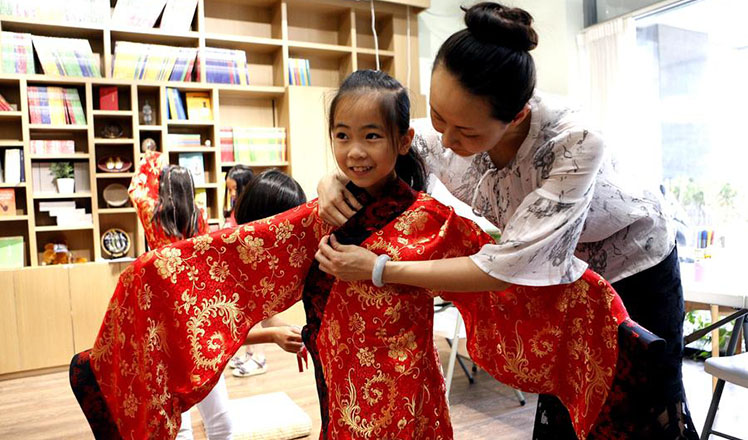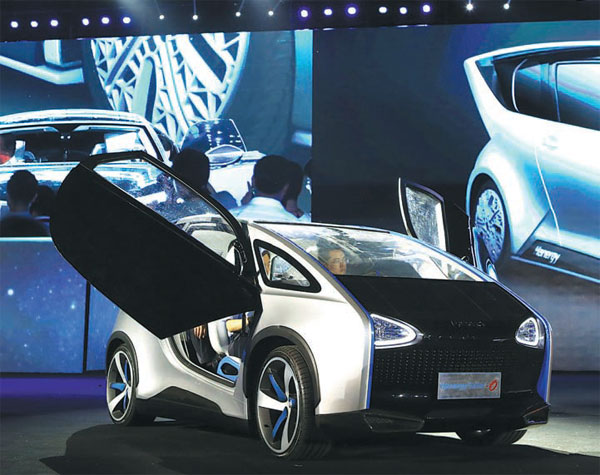Hanergy's solar cars set to shine in China's auto market
Updated: 2016-07-08 11:29
By Du Juan(China Daily)
|
|||||||||
As China's urbanization process has accelerated over the past few decades, the country has witnessed the explosion of its auto industry, and risen to become the world's largest auto manufacturer and seller.
This has, however, led to problems related to traffic congestion and pollution that have resulted in serious concerns about public health and well being. In response to these concerns, environmental-friendly electric vehicles have enjoyed a rapid rise in popularity in China, which has attracted huge investment from business giants in many sectors, especially energy and internet enterprises.
The e-commerce giant Alibaba Group Holding Ltd cooperated with vehicle producer SAIC Motor Corp Ltd to develop internet-connected vehicles with a total investment of 1 billion yuan ($160 million).
Based on its experience in internet technology, Alibaba will integrate its businesses, which range from e-commerce, finance, digital entertainment, and mapping and messaging, into internet-connected cars. The effect, according to the company, will be to "give vehicles a brain" via cloud computing and big data technology.
Tencent Holdings, another Chinese internet giant, has also entered the auto sector.
The company, cooperating with Taiwan's Hon Hai Precision Industry and Chinese luxury auto dealer China Harmony Auto Holding, works on exploring opportunities in the smart electric vehicles market.
Robin Li, chief executive officer of Chinese internet titan Baidu Inc, said the company is cooperating with automakers to develop smart vehicles.
The increasing cooperation between internet giants and car makers to produce internet-connected smart cars, which include electronic cars, has meant that traditional auto producers have, in response, begun to turn their focus towards developing electric cars as well, with the support of the central government.
In 2014, sales of new-energy cars only accounted for 0.25 percent of the total number. Under such developing market conditions, Hanergy Holding Group Ltd, a Chinese clean energy provider, has also decided to produce solar-powered electric cars.
It launched four prototype cars targeted at different markets in early July: The Solar O, Solar L, Solar A, and a sports car, the Solar R.
Unlike almost all other purely electric cars currently on the market, Hanergy solar cars are fitted with thin-film solar cells that convert solar power to electricity and, as a result, do not need regular plug-in charging.
During a meeting of the State Council in February, the authority said the government will give subsidies to companies that are conducting research into batteries for electric vehicles.
In addition, the government is encouraging the development and construction of charging stations and poles in residential buildings and offices buildings, as well as at sightseeing attractions and in parking lots through financial aid packages.
In a move that is likely to act as a genuine incentive for electric vehicle producers, government departments and related local city-level governments must also ensure that new-energy vehicles account for more than half of the total number of cars they purchase.
The government has also called for services including public transportation, taxis and logistics units to increase both their number and use of new energy cars.
In the last year, China surpassed the United States to become the leading producer and seller of electric vehicles.
According to official data, China produced 379,000 electric vehicles last year, four times as many as in 2014, accounting for 1.54 percent of the country's total auto production.
The data from the China Association of Automobile Industry shows that the country sold 331,000 new- energy cars last year, accounting for 1.34 percent of overall auto sales in China.
Building a fairer, cleaner world
As a world-leading thin-film solar power company, Hanergy Holding Group Ltd is a multinational clean energy provider that is committed to changing the world through clean power.
Established in 1994, the company has branches in provinces all over China, as well as countries in the Americas, Europe, the Middle East, Africa and other regions, with core businesses covering hydropower, wind power and thin-film solar power.
In addition to hydropower and wind power projects, the company engages in the integration of the entire thin-film value chain in the field of thin-film solar power, covering research and development, high-end equipment manufacturing, thin-film solar module production and construction of thin-film solar power plants.
It has invested in the construction of thin-film solar R&D as well as manufacturing bases throughout China, with a total production capacity of 3 GW.
Through global technical integration and independent innovation, Hanergy has become a world leader in thin-film solar technology.
Thin-film solar technology enables cutting-edge features such as flexibility, light weight, superior performance in low light conditions and diversified color and shapes. These unique qualities make the technology adaptable to a wide range of applications, including building integrated photovoltaics, residential power, agricultural applications, automobile power, electronics, consumer and specialty products, as well as commercial unmanned aerial vehicles.
In February 2014, Hanergy was selected by the MIT Technology Review as one of the 50 smartest companies in the world. It was the only Chinese energy company honored with the award.
The key to thriving in such a competitive industry is to prioritize technical innovation.
Hanergy has invested greatly in thin-film solar cell research. It has established six R&D centers in countries and areas including China, Silicon Valley in the United States, and Uppsala in Sweden.
As a company that focuses on clean energy and the development of a low-carbon society, Hanergy has been active in both public affairs and social responsibility. The company has donated and given care to HIV/AIDS orphans as well as programs and institutions such as China's Poverty Alleviation Program. It has also prioritized environmental protection and education equity.
Since 2002, Hanergy has donated more than 100 million yuan ($15 million) to health, education and poverty-alleviation causes.
Meanwhile, through its close association and work with the China Glory Society in Poverty Alleviation, Hanergy responds quickly to the national call for supporting minority populations and remote poverty-stricken areas in the western region of the country.
So far, Hanergy has invested 40 billion yuan to promote economic development in China's western areas, including the city of Lijiang in Yunnan province and Shuangliu city in Sichuan province.
The Chinese government is working hard to realize the 2020 poverty relief target, and China plans to lift 10 million people out of poverty annually between 2016 and 2020 through concrete and effective action.
Hanergy, as well as numerous other Chinese companies, will continue to contribute to the process of poverty alleviation.
dujuan@chinadaily.com.cn
|
New energy vehicles will set a new ground in China's auto market in the next few years. Provided to China Daily |

(China Daily 07/08/2016 page9)
- Eid al-Fitr celebrated worldwide
- Swedish PM looking at tightening laws after festival sex attacks
- British PM race cut to 3 hopefuls as 2 contenders exit contest
- Chinese herbalists offer free US treatment
- Obama praises Hillary's judgement hours after FBI's censure
- Rio mayor tells Olympic visitors: 'Don't expect New York or London'

 Griezmann scores twice to lift France into Euro final
Griezmann scores twice to lift France into Euro final
 Life goes on in flooded Wuhan
Life goes on in flooded Wuhan
 Paper cutouts offer a new view of world landmarks
Paper cutouts offer a new view of world landmarks
 Animals occupy Shanghai
Animals occupy Shanghai
 Beijing Muslims mark end of Ramadan
Beijing Muslims mark end of Ramadan
 Remember emerging heroes in China's floods
Remember emerging heroes in China's floods
 Ronaldo powers Portugal into Euro 2016 final
Ronaldo powers Portugal into Euro 2016 final
 Culture Insider: Six things you may not know about Minor Heat
Culture Insider: Six things you may not know about Minor Heat
Most Viewed
Editor's Picks

|

|

|

|

|

|
Today's Top News
Ministry slams US-Korean THAAD deployment
Two police officers shot at protest in Dallas
Abe's blame game reveals his policies failing to get results
Ending wildlife trafficking must be policy priority in Asia
Effects of supply-side reform take time to be seen
Chinese State Councilor Yang Jiechi to meet Kerry
Chinese stocks surge on back of MSCI rumors
Liang avoids jail in shooting death
US Weekly

|

|










